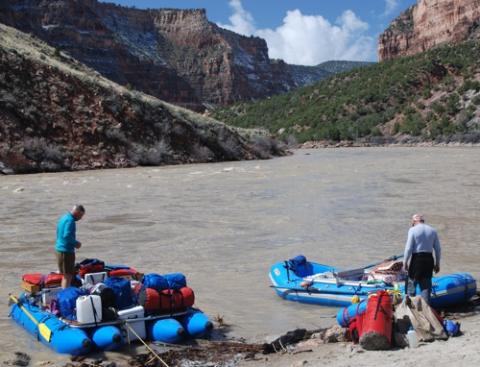Snowmelt's running around the National Park System, which makes it a perfect time to start thinking about paddling trips in the parks. Here are some ideas, and contacts, that can help you get wet in the months ahead.
Since it's still early for northern trips, we'll try to focus on rivers where the air temperature won't be below freezing for any trips you might want to take in the coming month or so.
New River Gorge National River
I've got a soft spot for the New, as I spent more than a few weekends guiding on it back in my college daze. Deep in the core of West Virginia, this great river -- one of the oldest in the country, despite its name -- is a classic that can be paddled in one or two days. There are plenty of outfitters who can help you get downstream, or, if you've got the skills, tackle it on your own.
Traveler trivia: Unlike most rivers, the New flows north. Its headwaters are in North Carolina.
Floating the Colorado River through the canyon is the grand daddy of all North American river trips. Scenery, geology, human history, it's all here. Getting a private permit can be an exasperating experience, so if you're looking for instant gratification, consider going with an outfitter.
Currently, the folks at Arizona River Runners are offering a deal for May floats: $250 off per person for six-day trips or $300 off per person for seven-day trips. These still can be kinda pricey, at $2,000 and $2,095 per person per trip, but you don't need to worry about rounding up gear, meals, or river knowledge.
This overlooked unit of the National Park System holds an overlooked river when it comes to paddling. The Yampa is the last undammed tributary to the Colorado River system, and it passes through some drop-dead gorgeous scenery that offers more than a few tempting avenues deeper into the monument's backcountry.
Also flowing through Dinosaur is the Green River, and one of the classic float trips in the West starts just above the Gates of Lodore on the Green and takes you down through Echo Park, Whirlpool Canyon, and Rainbow Park and on to Split Mountain. You can either plan your own trip and apply for a permit, or catch a ride with one of the outfitters.
For general information on floating in Dinosaur, check out this site.
The Snake is a river with lots of history to it. But most folks just appreciate it for the spectacular backdrop of the Tetons, and that's understandable. Paddle through Oxbow Bend and on down to Moose and you'll also no doubt encounter some wildlife -- eagles, osprey, perhaps some bison and antelope coming down to the riverbanks for a sip.
While many folks take on this river on their own for an afternoon or morning float, it can be tricky, so unless you're fairly well skilled and somewhat familiar with river, you probably would be wiser to go with an outfitter.
Ozark National Scenic Riverways
April and May are considered the off-season at this park, located in Missouri. There are two gin-clear rivers to paddle -- Jacks Fork, or the Current, which is divided into an "upper" and "lower section.
No matter which stretch you decide to paddle, you’ll be able to spend a day, or several days with overnights along the river, exploring the waters protected by the riverway.
There also are plenty of liveries in the area where you can rent a canoe or two, and you can even arrange to have them drop you at the put-in and collect you at trip's end.
To help plan a trip, be sure to check out this mile-by-mile guide to the rivers.
This Arkansas beauty flows for 135 miles through the Ozarks, giving you the option of day trips or multi-day floats. As a general rule, the best conditions for more challenging river trips occur in the spring along the Upper Buffalo (the western end of the park); the Middle and Lower Buffalo are normally best for floating spring into mid-summer.
The eastern end of the park (the Lower Buffalo) near Buffalo Point is usually a fine choice for family groups and less experienced canoeists. You can bring your own boat, or rent canoes and johnboats from a number of authorized concessioners in the area.
Any section of the river offers outstanding scenery, fine fishing and numerous locations for backcountry camping. Our Traveler's checklist to the Buffalo provides additional tips, and you can download a copy of the park's Currents newspaper for more information.
Big South Fork National River and Recreation Area
Hard along the Tennessee-Kentucky border, this 125,000-acre playground is built around the Big South Fork of the Cumberland River. And rightfully so, for this beautiful stream is fed by countless tributaries that add their contents to the main flow that over the ages has sculpted and carved its path through the sandstone landscape.
Just don't estimate this river. While it offers lots of easy paddling, there are some technical, highly rated stretches -- Angel Falls comes immediately to mind -- that can lead to drownings for the unprepared and under-skilled.
Help with outfitting and arranging a river trip can be found at this site.




Add comment